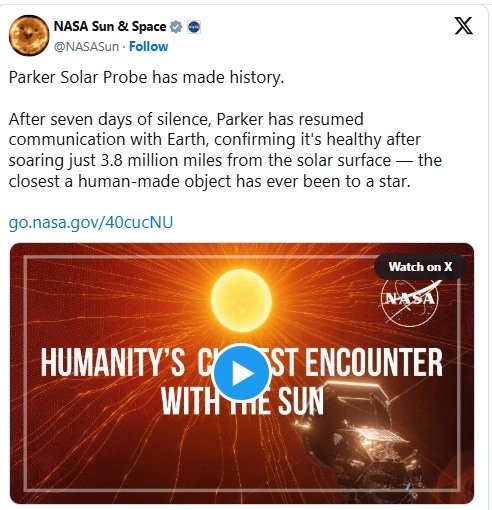NASA’s Parker Solar Probe made history with a record-setting closest flyby of the Sun on December 24. The accomplishment was verified by the US space agency on Friday, December 27.
NASA announced that its Parker Solar Probe is on a mission “to make contact” with the Sun. Launched in 2018, it has been steadily moving closer to the sun, utilizing Venus flybys to gravitationally draw itself into a more confined orbit around the sun.
The Parker Solar Probe withstood its unprecedented nearest encounter with the solar surface on December 24, 2024. It soared into the sun’s outer layer known as the corona.
The spacecraft lost communication with Earth due to limitations on signal transmission when it was near the sun. It was stated that the spacecraft couldn’t transmit a signal to its operators until December 27, suggesting its status after the flyby.
NASA successfully obtained the Parker Solar Probe’s “beacon tone” on December 26 (local time), confirming that the spacecraft is secure.
“After seven days of silence, Parker has resumed communication with Earth, confirming it’s healthy after soaring just 3.8 million miles from the solar surface — the closest a human-made object has ever been to a star,” NASA said.

Parker traveled at an astonishing speed of approximately 430,000 mph (690,000 kph), quick enough to reach Tokyo, Japan, from Washington, D.C., in less than a minute. According to the NASA website, the spacecraft withstood temperatures reaching 1,800 degrees Fahrenheit (982 degrees Celsius).
The spacecraft is anticipated to transmit comprehensive telemetry information about its condition on January 1.
Also read: Carlsen Disqualified from World Blitz Chess Championship Over Dress Code Breach”
NASA stated that by approaching the sun more closely than it ever has, the Parker Solar Probe will “uncover the mysteries of our star that can aid in protecting our technology and facilitate our future exploration.”
This detailed examination of the Sun enables the Parker Solar Probe to obtain data that assists researchers in gaining a deeper insight into how material in this area is heated to millions of degrees.
It might also assist in identifying the source of the solar wind (a constant outflow of material from the Sun), and reveal how energetic particles reach speeds close to that of light.
Earlier close encounters have assisted researchers in identifying the sources of formations in the solar wind and charting the outer edge of the Sun’s atmosphere.













